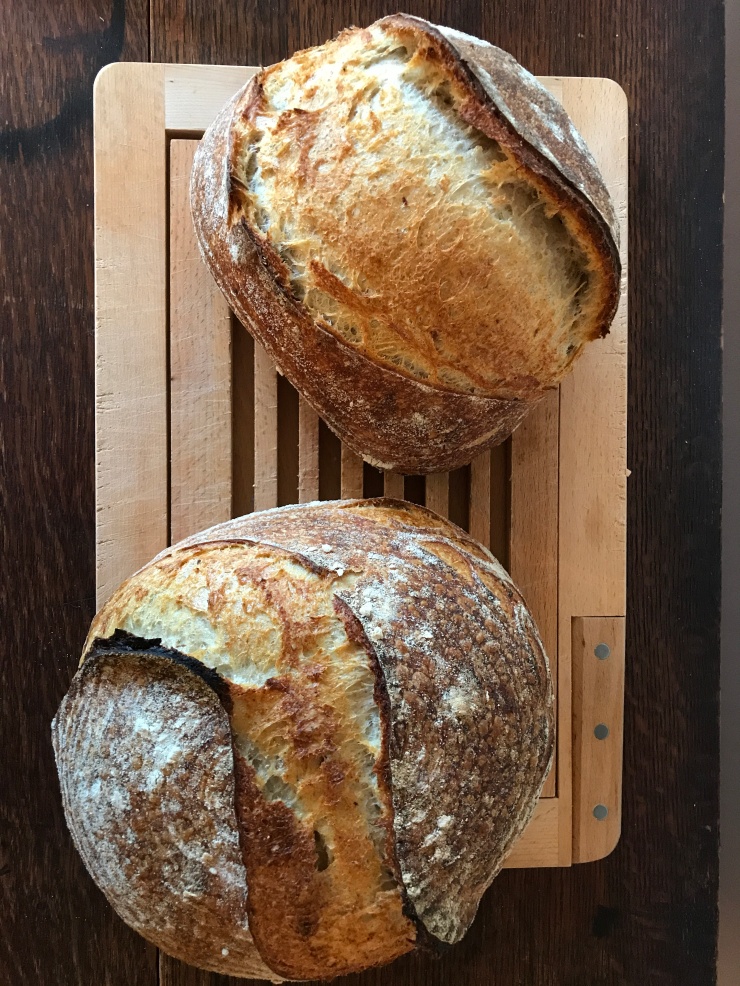Whenever I buy a big bag of potatoes, I like to bake them all as soon as I can, before they languish in a cupboard, start to sprout and end up in the compost. I choose organic because they have double the flavour and nutrition.
I scrub them under running water, but I don’t peel them. I prick each with a fork and leave them to dry on a clean tea towel as the oven heats to 425F. Once it’s ready and hot, I open the oven and try to put each tater on the hot rack without any fall-throughs to the oven floor. I love the sizzling sputter when the cold potato skins hit the hot bars.
It’s impossible to over-bake a potato, they just get fluffier and more intensely flavoured with time — but it is possible to have potato explosions when the taut, tight skin breaks. That’s why I prick them, to release the hot air. Yet, if you leave a little guy in there too along alongside bigger potatoes that are still under-done, you may hear a commotion behind the oven door and find sticky potato confetti splattered throughout.
The best time to eat a baked potato is when it is hot out of the oven with a melting nob of butter and a sprinkle of Vancouver Island salt.
The second best time is to bake it, again, in bread.
Potatoes and bread are partners in starch crime. A potato makes bread fluffier and the crumb richer. If you prefer to boil your potatoes, save the (cooled) cooking water, for that also makes a flavour-filled difference when added to levain, sourdough or yeasted dough.
The recipe below is loaded with garlic, too. Roasting garlic takes away the harsh bite of fresh and turns it into a sticky, spreadable goo. Equally sticky is this bread’s stiff levain. Running a plastic bowl scraper under water may help to remove it from the bowl in a large piece which you can break into chunks using wet hands.
Freshly baked bread, whether it contains potatoes or not, will make your friends and family delirious with joy and is worth every sticky messy gooey part of the cleanup.
Roasted Potato, Garlic and Spelt Levain
Adding potatoes to bread dough creates a fluffy, richly flavoured crumb, especially with the addition of roasted garlic. Yukon gold or yellow-fleshed potatoes are perfect for the job, but fingerlings are just as tasty, too.
2 medium potatoes (9 ounces) organic yellow-fleshed or Yukon gold potatoes
1 head organic garlic
Sea salt
Fresh rosemary or thyme
1 tbsp olive oil
Preheat oven 425 F. Slice 1/2 inch off the top of the garlic head, place upright on a square of aluminum foil, sprinkle with sea salt, dried or fresh rosemary or thyme and a teaspoon of olive oil, pull four corners of foil to top and close. Place in the oven. Prick potatoes with fork and place directly on the oven rack. Bake 45 min or until potatoes are tender and ready to explode.
1.5 oz 100% hydration starter
6.2 oz spring water
9.6 oz white flour
In a medium glass bowl, knead starter, water and flour to create a stiff levain. Cover and leave on counter to rise and create a dome, 7-8 hrs. I usually do this in the evening before bed.
11 oz organic whole spelt
11 oz organic white all-purpose or bread flour
13 oz spring water
9 oz roasted organic potatoes with skins on, crumbled
All the gooey garlic squeezed out of the roasted head of garlic
.6 oz sea salt
Next morning, mix spelt, white flour, water, potatoes, garlic and sea salt in mixer with paddle to combine. Remove 1.5 ounce of the levain and reserve, labelled and dated in fridge. Spoon out remaining levain in chunks and add to shaggy dough. Mix with dough hook for 3 min at first speed, increase to second speed and mix another 3 minutes, until dough is balling around the hook. Cover the bowl with plastic or a dinner plate and leave on counter for 45 min. Run your hand under water and start tugging the dough gently stretching it as far as you can without tearing then folding down on top. Repeat three more times, turning the bowl in quarters clockwise. Rest another 45 min.
Shape the dough and place upside down or crease side up in rice flour-dusted bannetons. Cover with shower caps. Refrigerate 18-24 hours.
To bake, preheat two dutch ovens (I use LodgePan Combo Cookers) in a 500 oven for 30-60 min depending on your oven. You want the pans to get dangerously hot and you must wear long and durable oven gloves when moving the pans in and out of the oven.
Remove fermented loaves from the fridge, take off shower caps and cut a piece of parchment paper to fit over each one. Place a rimless baking sheet over the parchment and holding both baking sheet and banneton, flip it over, lift off banneton and score the dough as desired.
Carefully remove one dutch oven from the oven, slide the scored dough into the base, cover and return to oven. Repeat. Bake 20 min. Carefully remove the dutch oven lids, reduce to 450 F and bake 15-20 more minutes or until deep golden brown.
Allow to cool on baking rack for at least 30 minutes before serving.


Sounds divine.
Most amazing photos of your bread, Mado! Those loaves look incredibly delicious!
Much love, Bill
Now in Maine and starting to rebuild my golf and tennis game👍🤗
>